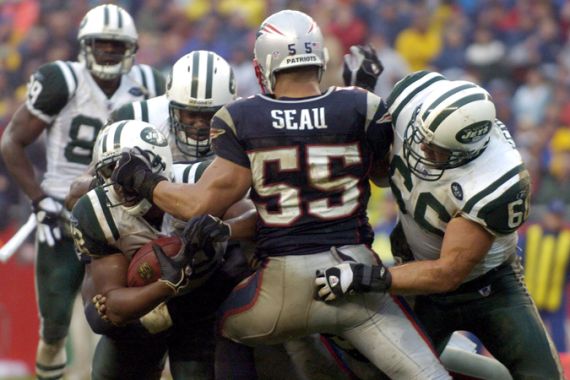NFL suicide turns focus on brain injuries
Former NFL star Junior Seau’s death is ruled as suicide, raising questions about football-related brain trauma.

Dave Duerson made it easy to understand why he was ending his tortured life.
Before the former Chicago Bears star fired a bullet into his chest last year, he left word with his family to have his brain examined for damage he believed was caused by repeated blows to the head from his hell-bent style on the football field.
Keep reading
list of 4 itemsBritish runner completes challenge to run length of Africa
Nagham Abu Samra: Palestine karate champion, victim of Israel’s war on Gaza
Funeral held for world marathon record holder Kelvin Kiptum
Junior Seau was an even bigger NFL star, and yet he ended his life on Wednesday in much the same way as Duerson and former Atlanta Falcons safety Ray Easterling: self-inflicted gunshot wounds.
Now friends wonder if the San Diego icon hoped his death might leave a greater legacy than any of his amazing feats on the gridiron.
Brain trauma
Former player Kyle Turley has no doubt that Seau wanted to make sure his brain could be studied for the tell-tale signs of football-related trauma.
“I don’t care what anybody says,” Turley told The Associated Press in a telephone interview Thursday.
“I know why he did it.”
Seau’s death was ruled a suicide by the San Diego County medical examiner’s office after an autopsy on Thursday. Officials were awaiting a decision by the family on whether to turn over Seau’s brain to researchers for study. A more in-depth investigative report could take up to 90 days.
Seau, 43, was one of the NFL’s most rugged players, a fierce-hitting linebacker selected for the Pro Bowl a dozen years in a row. He played for three teams over two decades, far longer than the average football career, before finally retiring for good at age 40.
Three years later, he decided to end his life. There were signs of trouble away from the field: a divorce, a domestic violence incident involving his girlfriend, though he was never formally charged.
Hours before his arrest, his car plunged over a 30-metre cliff in what some speculated was an attempt to kill himself. Seau survived with only minor injuries and insisted that he had simply fallen asleep at the wheel.
Unknown causes
Seau never indicated publicly he was having trouble with life after the NFL because of all those head injuries, and his family said he seemed happy.
That’s a far cry from Easterling, who died last month at age 62. He suffered from dementia and led a lawsuit filed by a number of prominent retired players, claiming the league did not do enough to deal with concussion-related injuries.
Notably, Seau did not join that lawsuit.
Also, it is not known if he wanted Boston University, which has been conducting research into football-related head trauma, to study his brain for signs of chronic traumatic encephalopathy, a progressive degenerative disease that can be caused by multiple concussions and only detected after death.
Thomas Demetrio, an attorney for the Duerson family, is not willing to say that Seau had the same motivation for ending his life. He said that would be “pure speculation.”